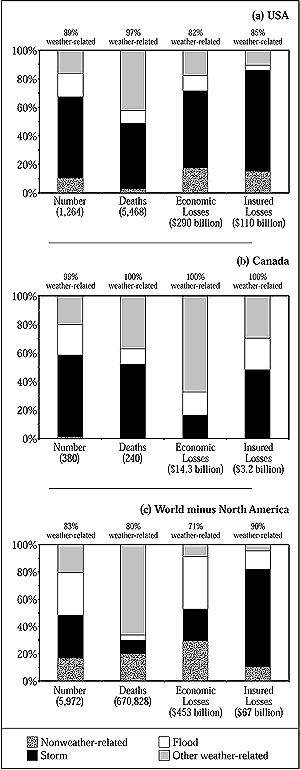|

Figure 15-4: Distribution of natural-disaster losses in (a) Canada,
(b) the United States, and (c) globally: 1985-1999 (Munich Re, 2000).
"Storm" includes hurricanes, tornadoes, and high winds. "Other"
includes weather-related events such as wildfire, landslides, avalanches,
extreme temperature events, droughts, lightning, frost, and ice/snow damages.
|
15.2.5.5. Development and Vulnerability to Extreme Events
The cost of natural disasters in North America has increased dramatically since
the mid-1980s, in spite of the goal of the International Decade for Natural
Disaster Reduction (the 1990s) to reduce the costs of natural disasters by 50%
by the year 2000. Although an increase in the number of storms may play a role
in these disasters, there is no question that the increasing costs are largely
the result of increased vulnerability (Pielke and Downton, 2000).
Natural disasters occur when social vulnerability is triggered by a natural
event (see Figure 15-3). Society responds to a
disaster through three overlapping activities: response and recovery, mitigation,
and preparedness. These activities alter future vulnerability (and therefore
the construct of future disasters)—reducing risk if they are done wisely,
or not if they are done otherwise. Often, however, mitigation that is designed
to protect against natural hazards increases long-term vulnerability (Burton
et al., 1993). An example is the levee system planned for the Grand Forks
region, as part of the post-1997 Red River flood mitigation scheme. NHC/DRI
(1999) notes, "If the levee system is constructed as planned…[it will]
have the potential to greatly increase damage and losses if the levee is breached
or overtopped in a future flood."
Superimposed on the changing development landscape is the possibility that
climate warming will reduce the risk of some extreme events and increase the
risk of others (Karl et al., 1996; White and Etkin, 1997). Changes in
the frequency, severity, and duration of extreme events may be among the most
important risks associated with climate change. In some parts of North America,
this includes fewer periods of extreme cold, fewer snowstorms (although there
may be an increase in the number of intense storms), increased spring flooding,
more frequent summer droughts, and more wildfires. Studies also suggest that
there will be a more thermodynamically unstable atmosphere in the future, which
probably will result in more frequent heavy rainfalls and possibly increased
hail risk and more tornadoes and downbursts (Etkin, 1996).
Studies suggest that El Niño and La Niña events may become more
frequent in the future, although there is still much uncertainty regarding predictions
of tropical phenomena (Henderson-Sellers et al., 1998; Timmermann and
Oberhuber, 1999). Any changes would affect the number of extreme events, including
the occurrence of Atlantic hurricanes because during El Niños (La Niña),
Atlantic hurricanes are less (more) frequent. Landsea et al. (1999) point
out that recent intensification of urban development along the U.S. Atlantic
coast parallels a reduction of hurricane activity from 1966 to the early 1990s;
they ask whether the United States is prepared for a recurrence of higher frequencies.
North American measures of property damage from severe storms are consistently
higher and the loss of life lower, compared to less-developed countries. Investments
in warning systems and disaster preparedness save lives. When these systems
are overwhelmed by extreme events, however, the damage can be catastrophic.
It is interesting that housing losses from extreme events generally are on the
same scale in North America as those in developing countries, particularly when
disaster strikes large urban centers (Comerio, 1997).
Older buildings often experience the greatest damage during extreme events.
New buildings, however, also are at risk if insufficient effort is made to ensure
compliance with building codes. Studies show that compliance with building codes
may have eliminated up to 25% of insured losses resulting from major hurricanes
(IBHS, 1999).
Damage from flooding in North America has increased in the past few decades
(Mileti, 1999). Land-use planning remains a powerful tool to help reduce the
loss of life and property. One study that indirectly illustrates this concept
is Brown et al. (1997a). They found that nonagricultural flood damage
from a set of storms moving through Michigan exceeded that of southwestern Ontario
by a factor of about 900, even though the flood yields in Ontario were greater
than those in Michigan. Their analysis ascribes the cause as greater development
in flood-prone areas. In Michigan, the storms generally exceeded land-use design
thresholds, whereas in Ontario they did not.Munich Re (1997) found that "the
extent of loss has not infrequently been increased through a false assessment
of the risk circumstances or in the pursuit of profit." If the amount of development
arising from the perception of reduced short-term risk tends to be disproportionate
to the real increased risk from rare events, long-term vulnerability is increased.
Mileti (1999) argues that "…our national [U.S.] path also is leading us
toward natural and related technological catastrophes in the next millennium
that are larger than any we have ever experienced …that is the future we
have designed for ourselves.… [We] have done more to postpone losses into
the future than to eliminate them." Social and economic trends suggest overall
increases in vulnerability; if natural triggers of disasters are exacerbated
as a result of climate change, it seems likely that more frequent and severe
natural disasters are going to occur in the future (see Section
15.2.7).
|